Abstract
In order to investigate the relationship between intratumoral vasculature and progression of gastric carcinomas and between vessel counts and survival of patients with non-early gastric carcinoma, we counted the intratumoral microvessels and compared their numbers with clinicopathological parameters, as well as with the patients' survival. Microvessels were stained with anti-CD34 monoclonal antibody before counting by microscopy (x200). In a group of 181 patients who had undergone tumour resection and were followed for more than 24 months the vessel counts for 83 patients with stage IV disease were significantly higher than those for patients with any other stage of disease. Among various clinicopathological variables, haematogenous metastasis, lymph node metastasis, peritoneal metastasis, stage IV disease and non-curative resection were more frequent in the patients with highly vascularized tumours (intratumoral vessel count > 155) than in those with less vascularized tumours. As a classification of stage IV disease such as haematogenous or peritoneal metastasis generally indicates non-curative resection, it can be considered that the development of stage IV disease is associated with the increase in tumour angiogenesis. Both univariate and multivariate analyses showed that the intratumoral vessel count was significantly predictive of overall survival, when tested as either a continuous or dichotomous variable. Cox hazards model analysis showed that the vessel count was one of the significant and independent prognostic variables. Patients with highly vascularized tumours were significantly more likely to die than those with less vascularized tumours. Assessment of tumour vasculature may therefore be important, not only for its prognostic value, but also as it may help to predict responses to angiogenesis-inhibiting agents.
Full text
PDF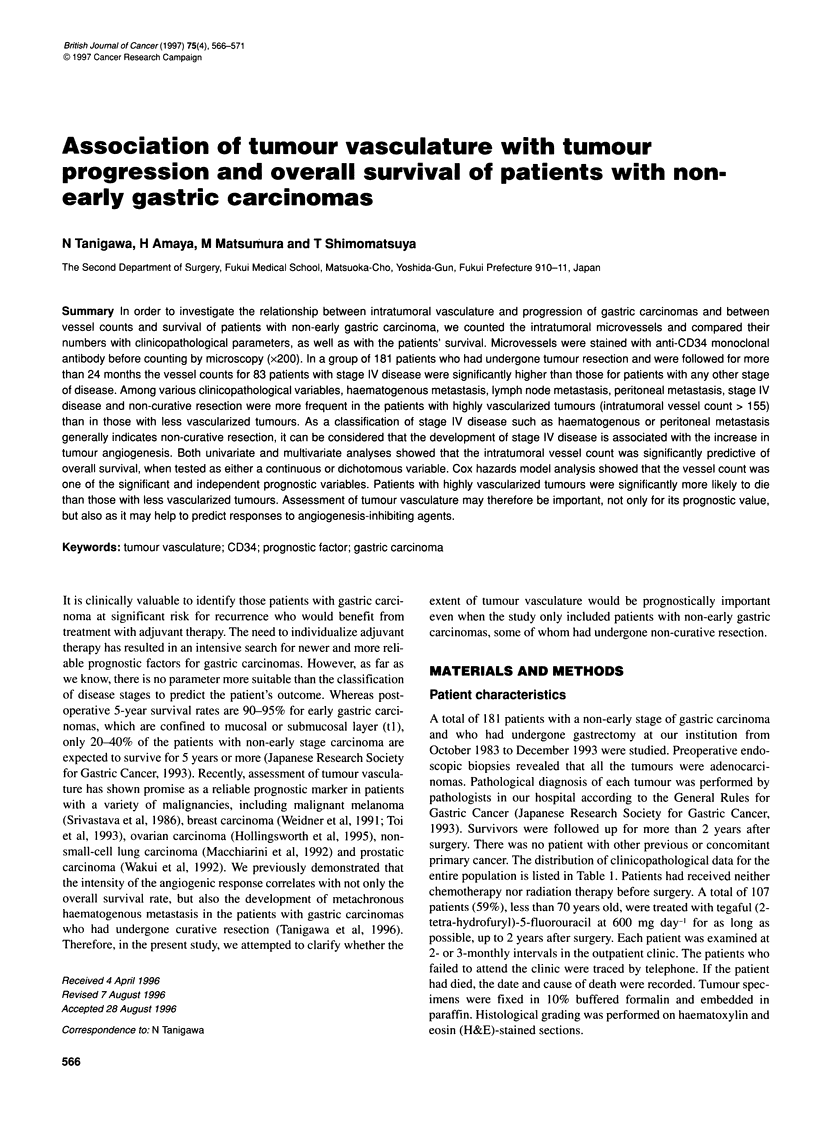
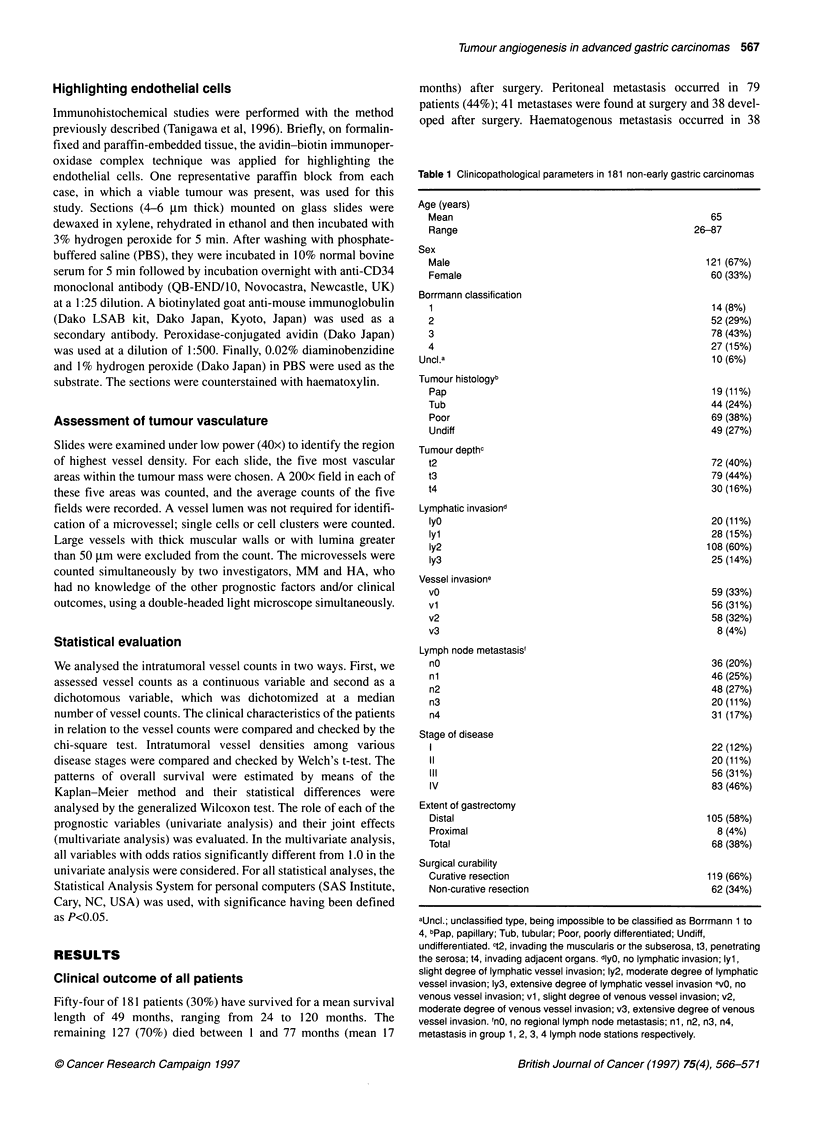
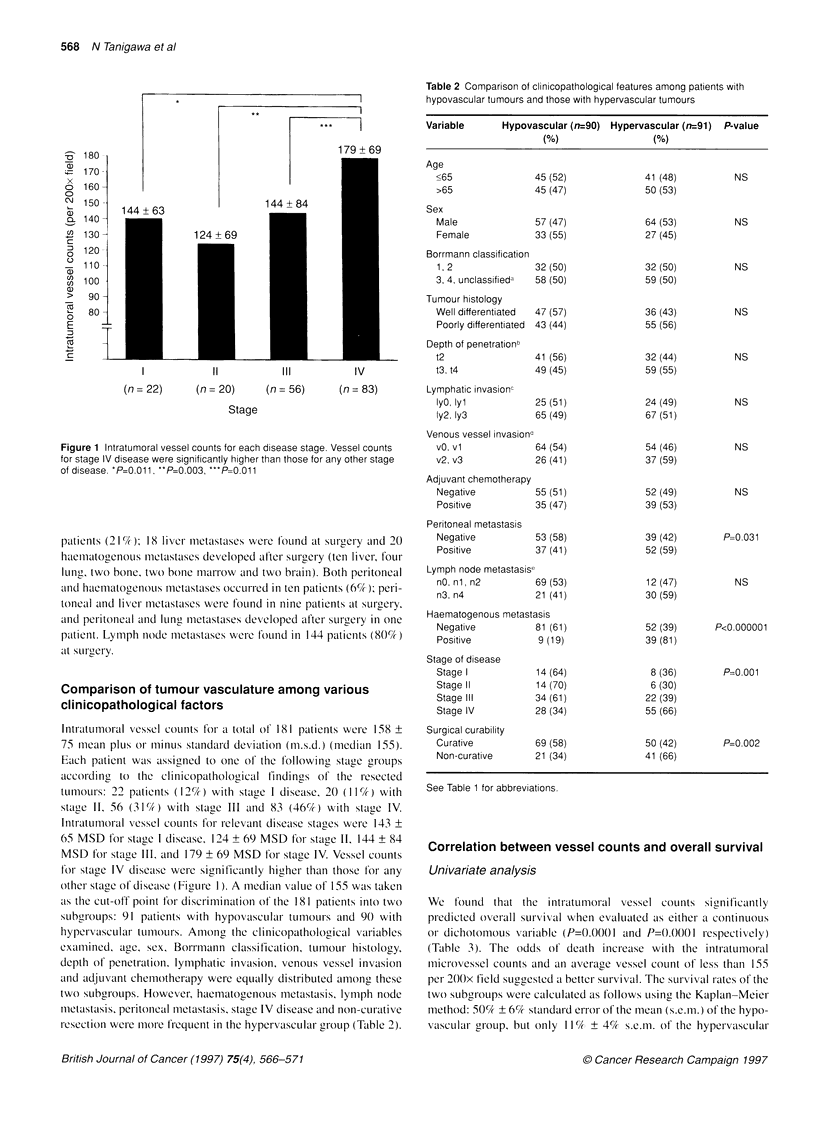
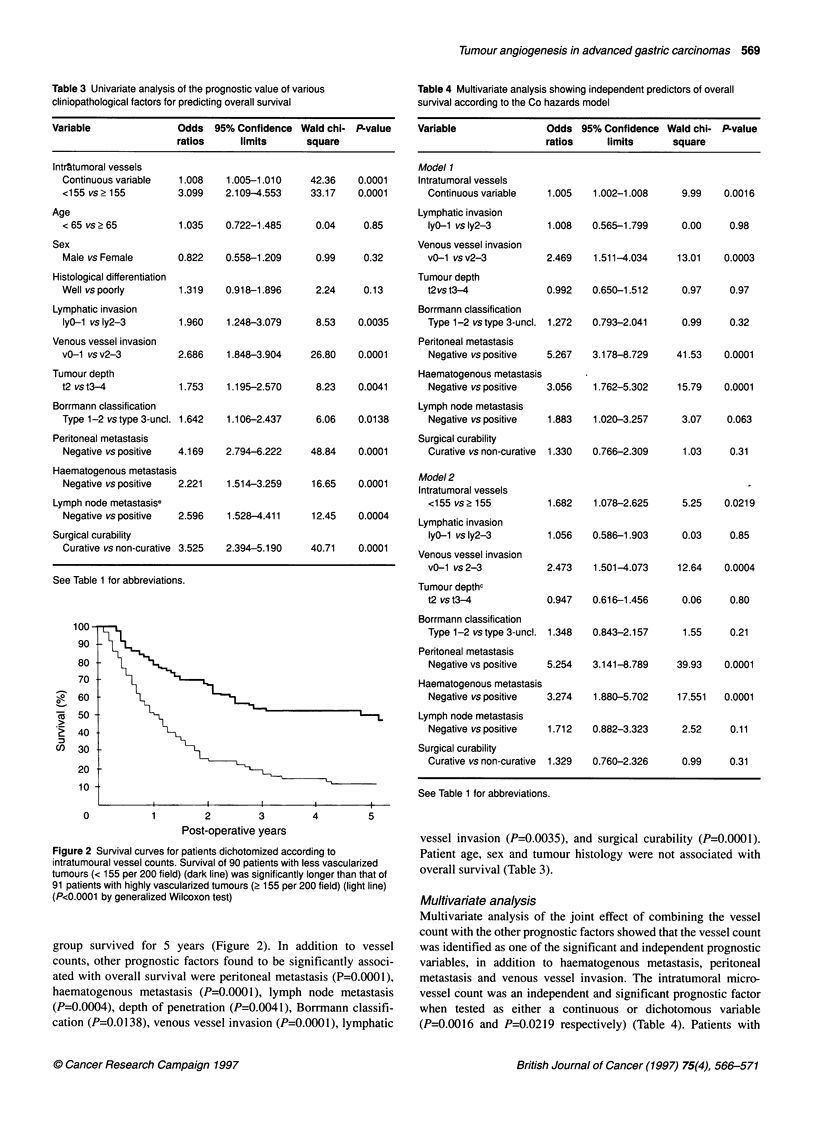
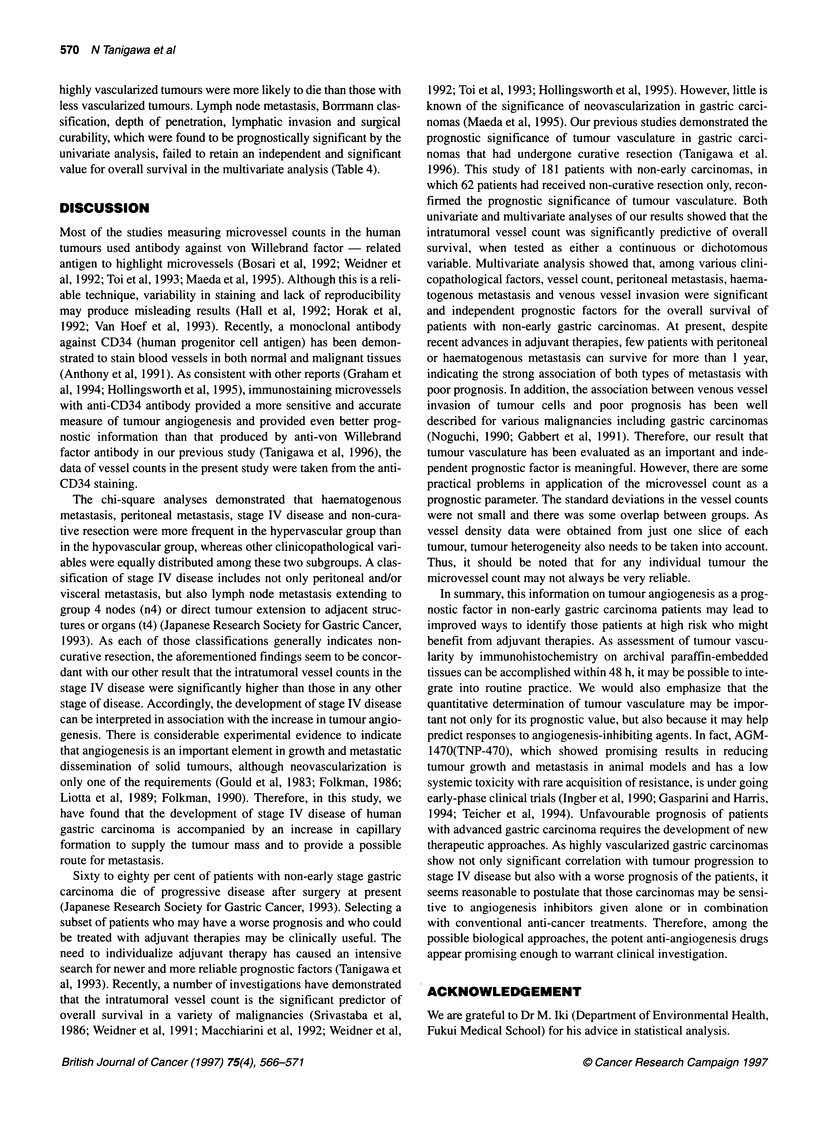
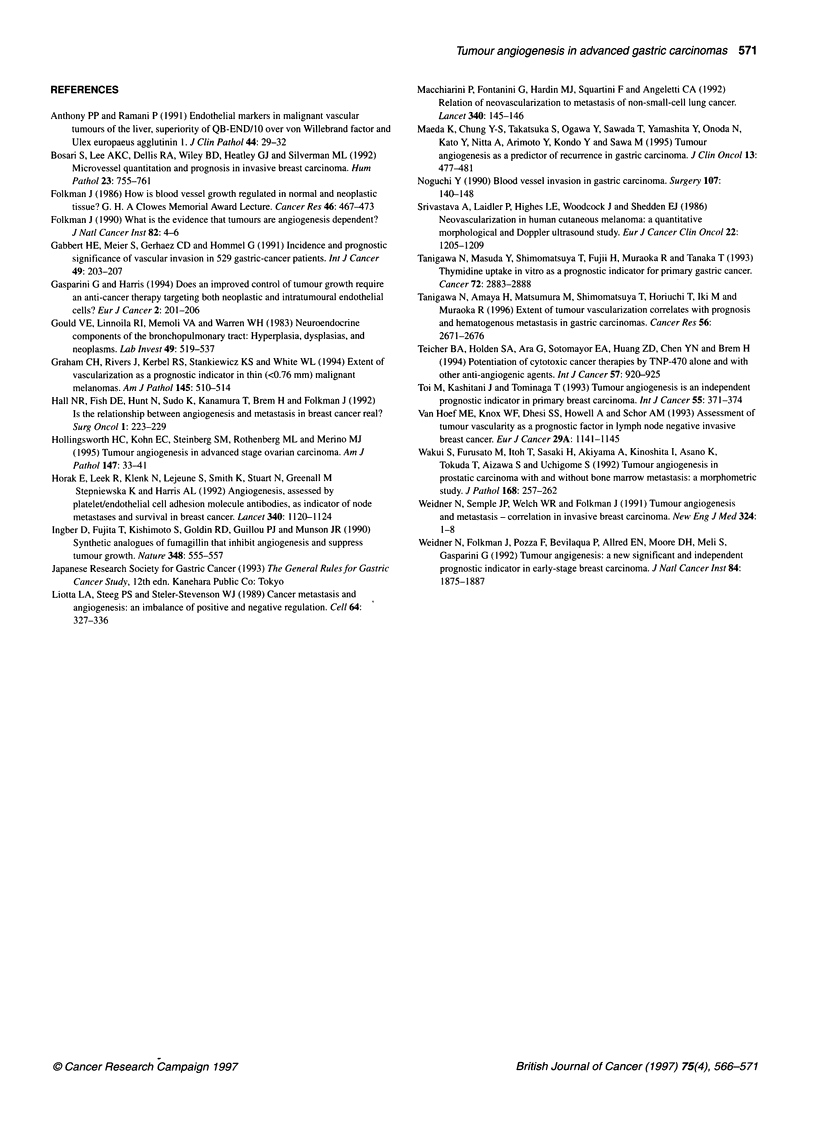
Selected References
These references are in PubMed. This may not be the complete list of references from this article.
- Anthony P. P., Ramani P. Endothelial markers in malignant vascular tumours of the liver: superiority of QB-END/10 over von Willebrand factor and Ulex europaeus agglutinin 1. J Clin Pathol. 1991 Jan;44(1):29–32. doi: 10.1136/jcp.44.1.29. [DOI] [PMC free article] [PubMed] [Google Scholar]
- Bosari S., Lee A. K., DeLellis R. A., Wiley B. D., Heatley G. J., Silverman M. L. Microvessel quantitation and prognosis in invasive breast carcinoma. Hum Pathol. 1992 Jul;23(7):755–761. doi: 10.1016/0046-8177(92)90344-3. [DOI] [PubMed] [Google Scholar]
- Folkman J. How is blood vessel growth regulated in normal and neoplastic tissue? G.H.A. Clowes memorial Award lecture. Cancer Res. 1986 Feb;46(2):467–473. [PubMed] [Google Scholar]
- Folkman J. What is the evidence that tumors are angiogenesis dependent? J Natl Cancer Inst. 1990 Jan 3;82(1):4–6. doi: 10.1093/jnci/82.1.4. [DOI] [PubMed] [Google Scholar]
- Gabbert H. E., Meier S., Gerharz C. D., Hommel G. Incidence and prognostic significance of vascular invasion in 529 gastric-cancer patients. Int J Cancer. 1991 Sep 9;49(2):203–207. doi: 10.1002/ijc.2910490210. [DOI] [PubMed] [Google Scholar]
- Gasparini G., Harris A. L. Does improved control of tumour growth require an anti-cancer therapy targeting both neoplastic and intratumoral endothelial cells? Eur J Cancer. 1994;30A(2):201–206. doi: 10.1016/0959-8049(94)90087-6. [DOI] [PubMed] [Google Scholar]
- Gould V. E., Linnoila R. I., Memoli V. A., Warren W. H. Neuroendocrine components of the bronchopulmonary tract: hyperplasias, dysplasias, and neoplasms. Lab Invest. 1983 Nov;49(5):519–537. [PubMed] [Google Scholar]
- Graham C. H., Rivers J., Kerbel R. S., Stankiewicz K. S., White W. L. Extent of vascularization as a prognostic indicator in thin (< 0.76 mm) malignant melanomas. Am J Pathol. 1994 Sep;145(3):510–514. [PMC free article] [PubMed] [Google Scholar]
- Hall N. R., Fish D. E., Hunt N., Goldin R. D., Guillou P. J., Monson J. R. Is the relationship between angiogenesis and metastasis in breast cancer real? Surg Oncol. 1992 Jun;1(3):223–229. doi: 10.1016/0960-7404(92)90068-v. [DOI] [PubMed] [Google Scholar]
- Hollingsworth H. C., Kohn E. C., Steinberg S. M., Rothenberg M. L., Merino M. J. Tumor angiogenesis in advanced stage ovarian carcinoma. Am J Pathol. 1995 Jul;147(1):33–41. [PMC free article] [PubMed] [Google Scholar]
- Horak E. R., Leek R., Klenk N., LeJeune S., Smith K., Stuart N., Greenall M., Stepniewska K., Harris A. L. Angiogenesis, assessed by platelet/endothelial cell adhesion molecule antibodies, as indicator of node metastases and survival in breast cancer. Lancet. 1992 Nov 7;340(8828):1120–1124. doi: 10.1016/0140-6736(92)93150-l. [DOI] [PubMed] [Google Scholar]
- Ingber D., Fujita T., Kishimoto S., Sudo K., Kanamaru T., Brem H., Folkman J. Synthetic analogues of fumagillin that inhibit angiogenesis and suppress tumour growth. Nature. 1990 Dec 6;348(6301):555–557. doi: 10.1038/348555a0. [DOI] [PubMed] [Google Scholar]
- Macchiarini P., Fontanini G., Hardin M. J., Squartini F., Angeletti C. A. Relation of neovascularisation to metastasis of non-small-cell lung cancer. Lancet. 1992 Jul 18;340(8812):145–146. doi: 10.1016/0140-6736(92)93217-b. [DOI] [PubMed] [Google Scholar]
- Maeda K., Chung Y. S., Takatsuka S., Ogawa Y., Sawada T., Yamashita Y., Onoda N., Kato Y., Nitta A., Arimoto Y. Tumor angiogenesis as a predictor of recurrence in gastric carcinoma. J Clin Oncol. 1995 Feb;13(2):477–481. doi: 10.1200/JCO.1995.13.2.477. [DOI] [PubMed] [Google Scholar]
- Noguchi Y. Blood vessel invasion in gastric carcinoma. Surgery. 1990 Feb;107(2):140–148. [PubMed] [Google Scholar]
- Srivastava A., Laidler P., Hughes L. E., Woodcock J., Shedden E. J. Neovascularization in human cutaneous melanoma: a quantitative morphological and Doppler ultrasound study. Eur J Cancer Clin Oncol. 1986 Oct;22(10):1205–1209. doi: 10.1016/0277-5379(86)90322-6. [DOI] [PubMed] [Google Scholar]
- Tanigawa N., Amaya H., Matsumura M., Shimomatsuya T., Horiuchi T., Muraoka R., Iki M. Extent of tumor vascularization correlates with prognosis and hematogenous metastasis in gastric carcinomas. Cancer Res. 1996 Jun 1;56(11):2671–2676. [PubMed] [Google Scholar]
- Tanigawa N., Masuda Y., Shimomatsuya T., Fujii H., Muraoka R., Tanaka T. Thymidine uptake in vitro as a prognostic indicator for primary gastric cancer. Cancer. 1993 Nov 15;72(10):2883–2888. doi: 10.1002/1097-0142(19931115)72:10<2883::aid-cncr2820721005>3.0.co;2-3. [DOI] [PubMed] [Google Scholar]
- Teicher B. A., Holden S. A., Ara G., Sotomayor E. A., Huang Z. D., Chen Y. N., Brem H. Potentiation of cytotoxic cancer therapies by TNP-470 alone and with other anti-angiogenic agents. Int J Cancer. 1994 Jun 15;57(6):920–925. doi: 10.1002/ijc.2910570624. [DOI] [PubMed] [Google Scholar]
- Toi M., Kashitani J., Tominaga T. Tumor angiogenesis is an independent prognostic indicator in primary breast carcinoma. Int J Cancer. 1993 Sep 30;55(3):371–374. doi: 10.1002/ijc.2910550305. [DOI] [PubMed] [Google Scholar]
- Van Hoef M. E., Knox W. F., Dhesi S. S., Howell A., Schor A. M. Assessment of tumour vascularity as a prognostic factor in lymph node negative invasive breast cancer. Eur J Cancer. 1993;29A(8):1141–1145. doi: 10.1016/s0959-8049(05)80304-1. [DOI] [PubMed] [Google Scholar]
- Wakui S., Furusato M., Itoh T., Sasaki H., Akiyama A., Kinoshita I., Asano K., Tokuda T., Aizawa S., Ushigome S. Tumour angiogenesis in prostatic carcinoma with and without bone marrow metastasis: a morphometric study. J Pathol. 1992 Nov;168(3):257–262. doi: 10.1002/path.1711680303. [DOI] [PubMed] [Google Scholar]
- Weidner N., Folkman J., Pozza F., Bevilacqua P., Allred E. N., Moore D. H., Meli S., Gasparini G. Tumor angiogenesis: a new significant and independent prognostic indicator in early-stage breast carcinoma. J Natl Cancer Inst. 1992 Dec 16;84(24):1875–1887. doi: 10.1093/jnci/84.24.1875. [DOI] [PubMed] [Google Scholar]
- Weidner N., Semple J. P., Welch W. R., Folkman J. Tumor angiogenesis and metastasis--correlation in invasive breast carcinoma. N Engl J Med. 1991 Jan 3;324(1):1–8. doi: 10.1056/NEJM199101033240101. [DOI] [PubMed] [Google Scholar]


